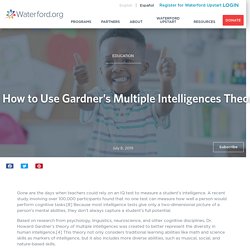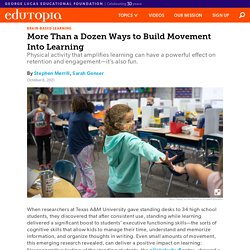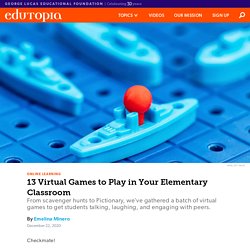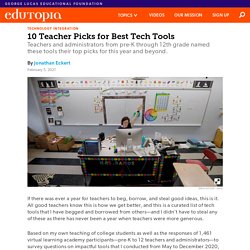

5 Major Technology Trends in Education in 2021 - KeenEthics. Anzhelika DanielkievichContent Manager Discovering the world of edtech and having a look at the latest technology trends in education Nearly 2 years ago, software development specialists talked a lot about machine learning and the Internet of Things.

Today, the use of these technologies has become a part of the distance learning strategy. But on the background of the already implemented tech solutions, we see something new. 8 Trends in Education Technology That Will Have A Major Impact. 30 Of The Most Popular Trends In Education. What are the most popular trends in education?

What about the most popular trends in education heading into 2021 specifically? Well, that’s a tricky question. Deciding what’s ‘trending’ is an important part of digital publishing and social media interaction. Facebook articles, Google News, Apple News, trending hashtags on twitter, and even our own TeachThought website all depend heavily on statistics. It’s easy to have a problem with this concept philosophically–namely that the most popular isn’t always the most effective or the ‘best.’ 5 Edtech Research Trends & Needs For The Future. The Jacobs Foundation recently awarded a five-year, nearly $11 million grant to the University of California, Irvine to create a collaborative network of educators and researchers to help design digital technologies for children.

The Connecting the EdTech Research EcoSystem (CERES) brings together experts in computer science, psychology, neuroscience, and education, to better utilize education technology’s potential. CERES will be headed by Candice Odgers, UCI professor of psychological science, and Gillian Hayes, UCI vice provost for graduate education and dean of the Graduate Division. The duo recently discussed the trends they see in edtech research and the questions they hope to pursue answers for with CERES. 1. Technology And Content Trends For 2021. With COVID-19 taking a grip over the world, organizations across the globe are forced to rethink how they conduct business, train, and equip their employees to meet the challenges posed by the disruption and business dynamics.

How are organizations gearing up for the coming year in upskilling and reskilling their employees? We will look at some key trends that will reshape the learning landscape in the coming year and beyond. The pandemic has created unprecedented challenges that have forced organizations to look for alternative forms of work such as work from home or remote working and bring virtual training to the fore. Trends in Educational Technology for 2020. What are the biggest educational technology trends we’ll see heading into the next decade?

We’re here to give you the inside scoop so you know what to pay attention to in 2020 and beyond. From artificial intelligence to video based learning to wellness tech, the emerging edtech trends have a lot in store for teachers and students alike. The online learning space is evolving rapidly, and edtech is a big part of that. K-12 Technology Education News & Trends. Emerging Digital Transformation Trends in Education. How to Use Gardner's Multiple Intelligences Theory to Help Struggling Students. Education How to Use Gardner’s Multiple Intelligences Theory to Help Struggling Students July 8, 2019 Subscribe Share on facebook Share on twitter.

(22) Do schools kill creativity? Gardner's Theory of Multiple Intelligences. When you hear the word intelligence, the concept of IQ testing may immediately come to mind. Intelligence is often defined as our intellectual potential; something we are born with, something that can be measured, and a capacity that is difficult to change. In recent years, however, other views of intelligence have emerged. One such conception is the theory of multiple intelligences proposed by Harvard psychologist Howard Gardner. Theory of Multiple Intelligences This theory suggests that traditional psychometric views of intelligence are too limited. Digital Citizenship. More Than a Dozen Ways to Build Movement Into Learning. When researchers at Texas A&M University gave standing desks to 34 high school students, they discovered that after consistent use, standing while learning delivered a significant boost to students’ executive functioning skills—the sorts of cognitive skills that allow kids to manage their time, understand and memorize information, and organize thoughts in writing.

Even small amounts of movement, this emerging research revealed, can deliver a positive impact on learning: Neurocognitive testing of the standing students, the pilot study notes, showed a 7 to 14 percent improvement in their cognitive performance, a noteworthy impact for such a simple intervention. Infusing classrooms with physical activity—or at least the option of some movement, at student discretion—isn’t just good for kids’ bodies, it’s also a powerful tool for improving learning and focus and reducing classroom management issues. 13 Virtual Games to Play in Your Elementary Classroom. Checkmate!

While most educators feel too worn out to take on anything else this year, classroom games—old and new—can provide a much-needed respite for students and teachers who are burned out on video lessons and miss social connection. We found some easy-to-use virtual games that elementary teachers are playing with their students this year, along with tips on how to incorporate them into the classroom. Gaming With Google Slides. Educators Turn to Bitmoji to Build Community and Engagement. Since remote learning started this past spring, Bitmojis have taken the education community by storm.

Available through the Bitmoji app, these customizable, mini-me avatars have become stand-in teachers running virtual classrooms, enforcing rules and expectations, collecting assignments—and making students smile, we’ve heard. Simply put, they’re fun. Amber Weaver, a second-grade teacher in Louisville, Kentucky, says she likes that her Bitmoji classroom—a virtual replica of her real one—makes resources like the school calendar easily accessible to her young students and provides them with a sense of virtual familiarity and stability during a tough time. But not everyone is a fan of the Bitmoji craze. Some educators believe that they’re a distracting fad and that teachers should be focusing more on creating effective lessons and supporting students’ well-being instead of creating cutesy virtual classrooms, according to an article in Education Week. 10 Teacher Picks for Best Tech Tools in Pre-K to 12th Grade. If there was ever a year for teachers to beg, borrow, and steal good ideas, this is it.

All good teachers know this is how we get better, and this is a curated list of tech tools that I have begged and borrowed from others—and I didn’t have to steal any of these as there has never been a year when teachers were more generous. Based on my own teaching of college students as well as the responses of 1,461 virtual learning academy participants—pre-K to 12 teachers and administrators—to survey questions on impactful tools that I conducted from May to December 2020, and over 70 webinars and virtual learning sessions I’ve conducted in that time, these are the top teacher-tested tech tools I have identified.
My learning has happened with my own students and through my own mistakes, and I received great ideas from educators across the U.S. and around the world. 4 Ways to Boost Elementary Students’ Working Memory. As learning specialists, we were keenly aware of the interaction between executive functioning skills and a student’s success in school long before we began the challenge of teaching remotely. Online learning has only magnified the importance of students’ executive functioning skills, which are process skills that allow people to successfully complete tasks. They include working memory, task initiation, planning, and prioritization.